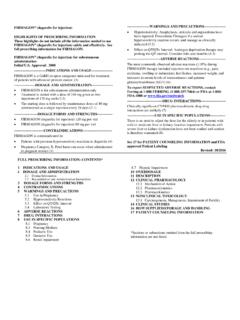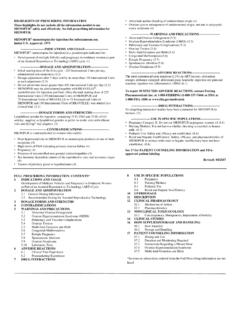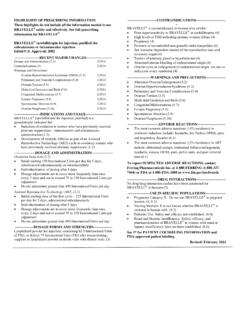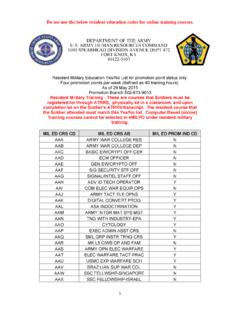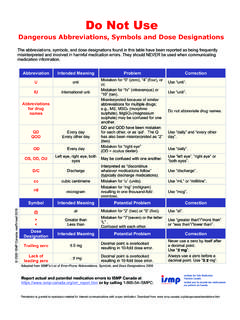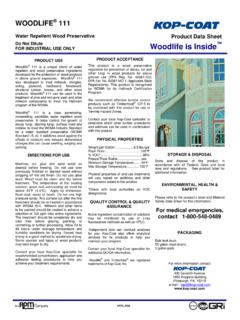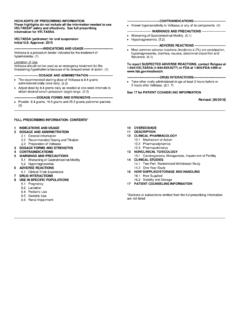Transcription of HIGHLIGHTS OF PRESCRIBING INFORMATION …
1 HIGHLIGHTS OF PRESCRIBING INFORMATION Hypersensitivity to tranexamic acid ( ). These HIGHLIGHTS do not include all the INFORMATION needed to use LYSTEDA safely and effectively. See full PRESCRIBING INFORMATION for -----------------------WARNINGS AND PRECAUTIONS------------------------ LYSTEDA. Concomitant use of LYSTEDA with Factor IX complex concentrates, anti-inhibitor coagulant concentrates or all-trans retinoic acid (oral LYSTEDA (tranexamic acid, USP) Tablets tretinoin) may increase the risk of thrombosis. ( ). Initial Approval: 1986 Visual or ocular adverse effects may occur with LYSTEDA. Immediately discontinue use if visual or ocular symptoms occur. ( ). ---------------------------------RECENT MAJOR CHANGES--------------------- In case of severe allergic reaction, discontinue LYSTEDA and seek Contraindications ( ) 10/2013 immediate medical attention. ( ). Warnings and Precautions ( ) 10/2013 Cerebral edema and cerebral infarction may be caused by use of LYSTEDA in women with subarachnoid hemorrhage.
2 ( ). Ligneous conjunctivitis has been reported in patients taking tranexamic ----------------------------INDICATIONS AND USAGE--------------------------- acid. ( ). LYSTEDA (tranexamic acid, USP) Tablets is an antifibrinolytic indicated for the treatment of cyclic heavy menstrual bleeding. (1) ------------------------------ADVERSE REACTIONS------------------------------- Most common adverse reactions in clinical trials ( 5%, and more frequent in ----------------------DOSAGE AND ADMINISTRATION----------------------- LYSTEDA subjects compared to placebo subjects) are headache, sinus and 1,300 mg (two 650 mg tablets) three times a day (3,900 mg/day) for a nasal symptoms, back pain, abdominal pain, musculoskeletal pain, joint pain, maximum of 5 days during monthly menstruation ( ) muscle cramps, migraine, anemia and fatigue. ( ). Renal impairment: Dosage adjustment is needed if serum creatinine concentration (Cr) is higher than mg/dL ( ) To report SUSPECTED ADVERSE REACTIONS, contact Ferring Cr above mg/dL and mg/dL: 1,300 mg (two 650 mg Pharmaceuticals Inc.)
3 At 1-888-FERRING (1-888-337-7464) or FDA at 1- tablets) two times a day (2,600 mg/day) for a maximum of 5 days 800-FDA-1088 or during menstruation Cr above mg/dL and mg/dL: 1,300 mg (two 650 mg ------------------------------DRUG INTERACTIONS---------------------------- --- tablets) once a day (1,300 mg/day) for a maximum of 5 days Concomitant therapy with tissue plasminogen activators may decrease the during menstruation efficacy of both LYSTEDA and tissue plasminogen activators. ( ). Cr above mg/dL: 650 mg (one 650 mg tablet) once a day (650 mg/day) for a maximum of 5 days during menstruation -----------------------USE IN SPECIFIC POPULATIONS------------------------ Geriatric Use: Lysteda is not indicated for use in postmenopausal ---------------------DOSAGE FORMS AND STRENGTHS---------------------- women ( ). Tablets: 650 mg (3) Renal impairment: Dosage adjustment is needed. ( , ). Hepatic impairment: No dosage adjustment is needed.
4 ( ). -------------------------------CONTRAIND ICATIONS------------------------------ Women who are using combination hormonal contraception ( ) See 17 for PATIENT COUNSELING INFORMATION and FDA- Women with active thromboembolic disease or a history or intrinsic risk approved patient labeling. of thrombosis or thromboembolism, including retinal vein or artery Revised: 03/2016. occlusion ( ). _____. FULL PRESCRIBING INFORMATION : CONTENTS*. 1 INDICATIONS AND USAGE 8 USE IN SPECIFIC POPULATIONS. 2 DOSAGE AND ADMINISTRATION Pregnancy Recommended Dosage Nursing Mothers Renal Impairment Pediatric Use 3 DOSAGE FORMS AND STRENGTHS Geriatric Use 4 CONTRAINDICATIONS Renal Impairment Thromboembolic Risk Hepatic Impairment Hypersensitivity to Tranexamic Acid 10 OVERDOSAGE. 5 WARNINGS AND PRECAUTIONS 11 DESCRIPTION. Thromboembolic Risk 12 CLINICAL PHARMACOLOGY. Severe Allergic Reaction Mechanism of Action Subarachnoid Hemorrhage Pharmacodynamics Ligneous Conjunctivitis Pharmacokinetics 6 ADVERSE REACTIONS 13 NONCLINICAL TOXICOLOGY.
5 Clinical Trial Experience Carcinogenesis, Mutagenesis, Impairment of Fertility Postmarketing Experience Animal Toxicology and/or Pharmacology 7 DRUG INTERACTIONS 14 CLINICAL STUDIES. Hormonal Contraceptives Three-Cycle Treatment Study Tissue Plasminogen Activators Six-Cycle Treatment Study Factor IX Complex Concentrates or Anti-Inhibitor Coagulant MBL Results over Time Concentrates 16 HOW SUPPLIED/STORAGE AND HANDLING. All-Trans Retinoic Acid (Oral Tretinoin) 17 PATIENT COUNSELING INFORMATION . *Sections or subsections omitted from the full PRESCRIBING INFORMATION are not listed FULL PRESCRIBING INFORMATION . 1 INDICATIONS AND USAGE. LYSTEDA (tranexamic acid, USP) Tablets is indicated for the treatment of cyclic heavy menstrual bleeding [see Clinical Studies (14)]. Prior to PRESCRIBING LYSTEDA, exclude endometrial pathology that can be associated with heavy menstrual bleeding. 2 DOSAGE AND ADMINISTRATION. Recommended Dosage The recommended dose of LYSTEDA for women with normal renal function is two 650 mg tablets taken three times daily (3900 mg/day) for a maximum of 5 days during monthly menstruation.
6 LYSTEDA may be administered without regard to meals. Tablets should be swallowed whole and not chewed or broken apart. Renal Impairment In patients with renal impairment, the plasma concentration of tranexamic acid increased as serum creatinine concentration increased [see Clinical Pharmacology ( )]. Dosage adjustment is needed in patients with serum creatinine concentration higher than mg/dL (Table 1). Table 1. Dosage of LYSTEDA in Patients with Renal Impairment LYSTEDA. Serum Creatinine Total Daily Adjusted Dose (mg/dL) Dose 1300 mg (two 650 mg tablets) two times a day for Cr above and 2600 mg a maximum of 5 days during menstruation 1300 mg (two 650 mg tablets) once a day for Cr above and 1300 mg a maximum of 5 days during menstruation 650 mg (one 650 mg tablet) once a day for Cr above 650 mg a maximum of 5 days during menstruation 3 DOSAGE FORMS AND STRENGTHS. 650 mg tablets 4 CONTRAINDICATIONS. Thromboembolic Risk do not prescribe LYSTEDA to women who are using combination hormonal contraception known to have any of the following conditions: Active thromboembolic disease ( , deep vein thrombosis, pulmonary embolism, or cerebral thrombosis).
7 A history of thrombosis or thromboembolism, including retinal vein or artery occlusion An intrinsic risk of thrombosis or thromboembolism ( , thrombogenic valvular disease, thrombogenic cardiac rhythm disease, or hypercoagulopathy). Venous and arterial thrombosis or thromboembolism, as well as cases of retinal artery and retinal vein occlusions, have been reported with tranexamic acid. Hypersensitivity to Tranexamic Acid do not prescribe LYSTEDA to women with known hypersensitivity to tranexamic acid [see Warnings and Precautions ( ) and Adverse Reactions ( )]. 5 WARNINGS AND PRECAUTIONS. Thromboembolic Risk Concomitant Use of Hormonal Contraceptives Combination hormonal contraceptives are known to increase the risk of venous thromboembolism, as well as arterial thromboses such as stroke and myocardial infarction. Because LYSTEDA is antifibrinolytic, the risk of venous thromboembolism, as well as arterial thromboses such as stroke, may increase further when hormonal contraceptives are administered with LYSTEDA.
8 This is of particular concern in women who are obese or smoke cigarettes, especially smokers over 35 years of age. Women using hormonal contraception were excluded from the clinical trials supporting the safety and efficacy of LYSTEDA, and there are no clinical trial data on the risk of thrombotic events with the concomitant use of LYSTEDA with hormonal contraceptives. However, there have been US. postmarketing reports of venous and arterial thrombotic events in women who have used LYSTEDA. concomitantly with combination hormonal contraceptives. For this reason, concomitant use of LYSTEDA with combination hormonal contraceptives is contraindicated. [see Contraindications ( ). and Drug Interactions ( )]. Factor IX Complex Concentrates or Anti-Inhibitor Coagulant Concentrates LYSTEDA is not recommended for women taking either Factor IX complex concentrates or anti-inhibitor coagulant concentrates because the risk of thrombosis may be increased [see Drug Interactions ( ) and Clinical Pharmacology ( )].
9 All-Trans Retinoic Acid (Oral Tretinoin). Exercise caution when PRESCRIBING LYSTEDA to women with acute promyelocytic leukemia taking all-trans retinoic acid for remission induction because of possible exacerbation of the procoagulant effect of all-trans retinoic acid [see Drug Interactions ( ) and Clinical Pharmacology ( )]. Ocular Effects Retinal venous and arterial occlusion has been reported in patients using tranexamic acid. Patients should be instructed to report visual and ocular symptoms promptly. In the event of such symptoms, patients should be instructed to discontinue LYSTEDA immediately and should be referred to an ophthalmologist for a complete ophthalmic evaluation, including dilated retinal examination, to exclude the possibility of retinal venous or arterial occlusion. Severe Allergic Reaction A case of severe allergic reaction to LYSTEDA was reported in the clinical trials, involving a subject who experienced dyspnea, tightening of her throat, and facial flushing that required emergency medical treatment.
10 A case of anaphylactic shock has also been reported in the literature, involving a patient who received an intravenous bolus of tranexamic acid. Subarachnoid Hemorrhage Cerebral edema and cerebral infarction may be caused by use of LYSTEDA in women with subarachnoid hemorrhage. Ligneous Conjunctivitis Ligneous conjunctivitis has been reported in patients taking tranexamic acid. The conjunctivitis resolved following cessation of the drug. 6 ADVERSE REACTIONS. Clinical Trial Experience Because clinical trials are conducted under widely varying conditions, adverse reaction rates observed in the clinical trials of a drug cannot be directly compared to the rates in the clinical trials of another drug and may not reflect the rates observed in clinical practice. Short-term Studies The safety of LYSTEDA in the treatment of heavy menstrual bleeding (HMB) was studied in two randomized, double-blind, placebo-controlled studies [see Clinical Studies (14)].
